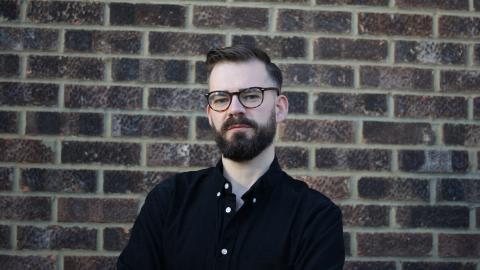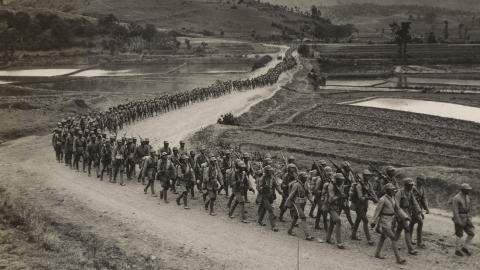
'It's a delightful aircraft to fly': The pilot who circumnavigated the earth in an 80-year-old Spitfire
Image: Pilot Matt Jones | 'Silver Spitfire: The Longest Flight'
Silver Spitfire: The Longest Flight is a feature-length documentary which follows a British expeditionary team's attempt at the world's first circumnavigation of the Earth in an 80-year-old Spitfire. In what is a test of human and mechanical endurance, this daring four-month odyssey tests the limits of what is possible and showcases one of the most loved aircraft ever built. Silver Spitfire: The Longest Flight airs Sunday, 12 November at 9pm on Sky HISTORY.
Sky HISTORY spoke to pilot Matt Jones and director Benjamin Uttley about the record-breaking journey, the extensive challenges they faced, and what it was like to fly one of history's most iconic planes.
What makes the Spitfire such an iconic plane?
Benjamin: The Spitfire represents the people and spirit of freedom against tyranny and victory against seemingly impossible odds. Her design is iconic and timeless. I’ve never seen a machine reduce so many people to ears of emotion.
Matt: The Spitfire’s beautiful shape and unforgettable engine sound make it special outside of its history. Combine it with the effect it had on our world, its defence of democracy and you have something exceptional. And everyone seems to have some connection to it. Grandad flew it. Grandma built it. Uncle maintained. It became a member of the family, and families passed down their stories of it to the next generations. Cut a Spitfire in half and you’ll find the flag of the UK.
What inspired you to undertake this amazing journey?
Benjamin: In a world where pessimism and negativity seem to rule the headlines, the thought of doing something to inspire people was a huge draw. A story straight from the golden age of aviation.
Matt: We’re so proud of the association we have with this aircraft and the people we commemorate with it each time we fly. Most of that focus is based on its efforts in the UK, particularly the Battle of Britain in 1940, however, the Spitfire flew for Allied forces in wartime all around the world and we wanted the chance to commemorate those people and those moments too.
What were the biggest challenges in circumnavigating the earth in an 80-year-old aircraft?
Benjamin: The problems and challenges were numerous. From a filming perspective, it was taking stills and video solo, with a hatch I could open in the support plane to capture the team. It was always a worry that I could be filming the death of a friend.
Matt: The biggest challenges were permission, fuel, and weather. First of all, the Spitfire is not a recognised aircraft type around the world anymore and therefore we had to ballot every country for permission to fly in its airspace.
In some countries, this was fairly straightforward but in others, it was much harder. On the day we embarked we still didn’t have permission in two of the countries we were going to. Then, because general aviation – where people fly their own aircraft for pleasure – isn’t commonplace in many countries we had to have special fuel delivered to those countries.
Getting permission for this wasn’t easy and often it had to be guarded too. In Vietnam, we failed to get the fuel we needed delivered but fortunately, the next leg was short enough that we still had enough fuel on board to get there. By far the biggest challenge was the weather. The Spitfire isn’t allowed to fly in clouds anymore, so we always had to be able to see where we were going. On legs of up to 800 miles at a time this was a difficult thing to judge, and we were daily making tough decisions on whether we could attempt to go or not, often with very poor weather information to go on.
What is the Spitfire like to fly?
Matt: It’s a delightful aircraft to fly. It has lots of power and manoeuvrability means you just have to think about where you want to be, and it has taken you there. Its wings are like your own. Landing can be a little tricky and takes a while to get the knack of. In terms of fighting in it… I’m afraid I can’t answer that one!
What part of the journey were you and the team most worried about?
Benjamin: The pilots were always worried about the water crossings. For me that was key but also from a filming perspective, Pakistan was a worry. We had a lot of cameras on board, and they were not very welcome. Having the plane searched for them was very disconcerting.
Matt: Water crossings were a huge concern, as were the crossings of the Polar regions, such as Greenland, Northern Canada, Alaska, and Russia.
Were there any moments of genuine risk?
Benjamin: Pakistan as mentioned above and then the sea fog over Greenland and remote parts of Canada. Ian Smith MBE (AKA Smithy) flying through Japan during Super Typhoon season was not a lot of fun either.
Matt: We made a few bad decisions on the weather in an attempt to progress when perhaps we should have been more patient. These decisions put us in jeopardy on a few occasions.
You flew over some stunning landscapes in the series, which were the most memorable?
Benjamin: For me as a filmmaker, I was spoilt for choice. The vast icecaps over Greenland with huge cobalt blue lakes, flying past the Statue of Liberty and the mighty New York metropolis below and then parts of the Desert which were reminiscent of Lawrence of Arabia in the colours and hues and of course the Pyramids in Egypt. The Spitfire looks like she belongs there. The Alps weren’t bad either!
Matt: My three favourite legs were flying over the ice of Greenland, the remoteness of the flights on the East coast of Russia and the trip from Jordan past the Suez Canal and over the Pyramids into Egypt.
You visited so many different countries on your trip, which location stood out for you and why?
Benjamin: Jodphur in India had some of the best hospitality for us. A vibrant city and fantastic hosts. Also, Myanmar and its Golden Pagodas. I’d never realised how large it was and it’s tragic to see how it’s once again riddled with oppression and unrest.
Matt: Yes, Jodhpur in India was very Special indeed. We were hosted by the Maharaja in his palace which was incredible. But it’s really difficult to pick anywhere specifically. Some of the vistas we saw, low level over the earth’s multitude of different terrains, will never leave me.
What did it feel like breaking the Guinness World Record?
Matt: We were very proud indeed to set the world record. This had never been attempted before and to be successful at the first attempt was a testament to the amount of effort & planning we put in and the huge support we received.
Can you explain the Tom Cruise connection?
Matt: Tom is a very passionate and talented aviator. He became a friend of the team through this passion and wanted to support us on this adventure where he could.



















